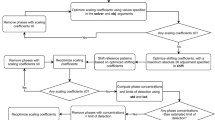Abstract
The Reynolds Cup (RC) is a unique round-robin competition that was established by The Clay Minerals Society in 2000 to assess the level of precision and accuracy that is attainable for the mineralogical analysis of a wide range of complex clay-rich materials. Although the Reynolds Cup roundrobin allows any possible analysis methods, X-ray diffraction (XRD) is by far the most frequently used technique. It is not only used to identify components, but also for quantitative phase analysis (QPA). QPA means determination of the relative concentrations of the coexisting phases in a mixture, commonly as a weight percent (wt.%) or mass fraction. Several approaches allow a quantitative determination of mineral contents, such as the Rietveld method (Rietveld, 1967). The successful application of the Rietveld method for QPA requires that all components are correctly identified and that the component diffraction patterns are appropriately described, which is preferably based on structure. In addition, the quality of a Rietveld quantification also depends on suitable sample preparation and measurement conditions, as well as a correct description of instrument configurations. Results from all previous Reynolds Cup contests show that a successful quantification depends strongly on the skill of users. Although the refinement procedure itself is automatic and, therefore, user independent, the results are strongly influenced by the structural models and refinable parameters that are selected and on the limitations of those parameters. Selected examples for the successful application of Rietveld refinement as well as the limitations of the method will be discussed in this article. The goal of the present work was to demonstrate that the Rietveld method is in principle capable of quantifying all Reynolds Cup samples with a high degree of accuracy, but sample specific difficulties and analysts’ inexperience may impede successful application. Incorrect results are often not indicated simply by low residuals or good fits. All refinement results should be validated and corrected using supplementary techniques, even if the results appear acceptable.
Similar content being viewed by others
References
Bergmann, J., Friedel, P., and Kleeberg, R. (1998) BGMN - a new fundamental parameter based Rietveld program for laboratory X-ray sources, its use in quantitative analysis and structure investigations. CPD Newsletter, Commission of Powder Diffraction, International Union of Crystallography, 20, 5–8.
Bergmann, J. and Kleeberg, R. (1998) Rietveld analysis of disordered layer silicates. Materials Science Forum, 278-281, 300–305.
Bruker AXS, 2009. Topas V4.2: General Profile and Structure Analysis Software for Powder Diffraction Data. Bruker AXS, Karlsruhe, Germany.
Bish, D.L. and Howard, S.A. (1988) Quantitative phase analysis using the Rietveld method. Journal of Applied Crystallography, 21, 86–91.
Guthrie, G.D., Jr., Bish, D.L., and Reynolds, R.C., Jr. (1995) Modeling the X-ray diffraction pattern of opal-CT. American Mineralogist, 80, 969–872.
Hill, R.J. and Howard, C.J. (1987) Quantitative phase analysis from neutron powder diffraction data using the Rietveld method. Journal of Applied Crystallography, 20, 467–474.
Madsen, I.C., Scarlett, N.V.Y., and Kern, A. (2011) Description and survey of methodologies for the determination of amorphous content via X-ray powder diffraction. Zeitschrift für Kristallographie, 226, 944–955.
Moore, D.M. and Reynolds, R.C., Jr. (1997) X-ray Diffraction and the Identification and Analysis of Clay Minerals. Oxford University Press, Oxford, 378 pp.
Raven, M.D. and Self, P.G. (2011) Secrets to winning the 5th Reynolds Cup competition. Abstracts: 48th Annual Meeting of The Clay Minerals Society. September 2011. Lake Tahoe, Nevada, USA, 85, http://www.clays.org/48th_annual_meeting_website/schedule_v4.pdf.
Raven, M.D. and Self, P.G. (2017) Outcomes of 12 years of the Reynolds Cup quantitative mineral analysis round robin. Clays and Clay Minerals, 65, 122–134.
Rietveld, H.M. (1967) Line profiles of neutron powder-diffraction peaks for structure refinement. Acta Crystallografica, 22, 151–152.
Scarlett, N.V.Y. and Madsen, I.C. (2006) Quantification of phases with partial or no known crystal structures. Powder Diffraction, 21, 278–284.
Taylor, J.C. (1991) Computer programs for standardless quantitative analysis of minerals using the full powder diffraction profile. Powder Diffraction, 6, 2–9.
Taylor, J.C. and Matulis C.E. (1994) A new method for Rietveld clay analysis: Part 1. Use of a universally measured standard profile for Rietveld quantification of montmorillonites. Powder Diffraction, 9, 119–123.
Treacy, M.M., Newsam, J.M., and Deem, M.W. (1991) A general recursion method for calculating diffracted intensities from crystals containing planar faults. Proceedings of the Royal Society of London, A433, 499–520.
Ufer, K., Kleeberg, R., Bergmann, J., Curtius, H., and Dohrmann, R. (2008) Refining real structure parameters of disordered layer structures within the Rietveld method. Zeitschrift für Kristallographie Suppl., 27, 151–158.
Ufer, K., Kleeberg, R., Bergmann, J., and Dohrmann, R. (2012) Rietveld refinement of disordered illite-smectite mixed layered structures by a recursive algorithm. Part II: Powder-pattern refinement and quantitative phase analysis. Clays and Clay Minerals, 60, 535–552
Ufer, K., Roth, G., Kleeberg, R., Stanjek, H., and Dohrmann, R. (2004) Description of X-ray powder pattern of turbostratically disordered layer structures with a Rietveld compatible approach. Zeitschrift fur Kristallographie, 219, 519–527.
Viani, A., Gualtieri, A.F., and Artioli, G. (2002) The nature of disorder in montmorillonite by simulation of X-ray powder patterns. American Mineralogist, 87, 966–975.
Westphal, T., Füllmann, T., and Pöllmann, H. (2009) Rietveld quantification of amorphous portions with an internal standard - Mathematical consequences of the experimental approach. Powder Diffraction, 24, 239–243.
Young, R.A. (1993) Introduction to the Rietveld method. Pp. 1–38 in: The Rietveld Method, Oxford University Press, Oxford, UK.
Author information
Authors and Affiliations
Corresponding author
Rights and permissions
About this article
Cite this article
Ufer, K., Raven, M.D. Application of the Rietveld Method in the Reynolds Cup Contest. Clays Clay Miner. 65, 286–297 (2017). https://doi.org/10.1346/CCMN.2017.064063
Received:
Revised:
Published:
Issue Date:
DOI: https://doi.org/10.1346/CCMN.2017.064063




